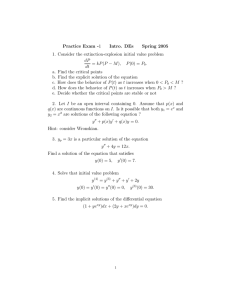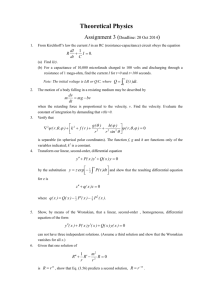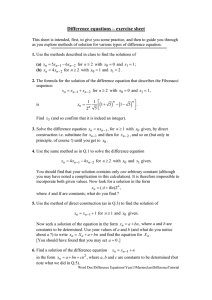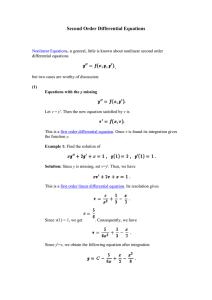Principle of Superposition. Wronskian.
advertisement
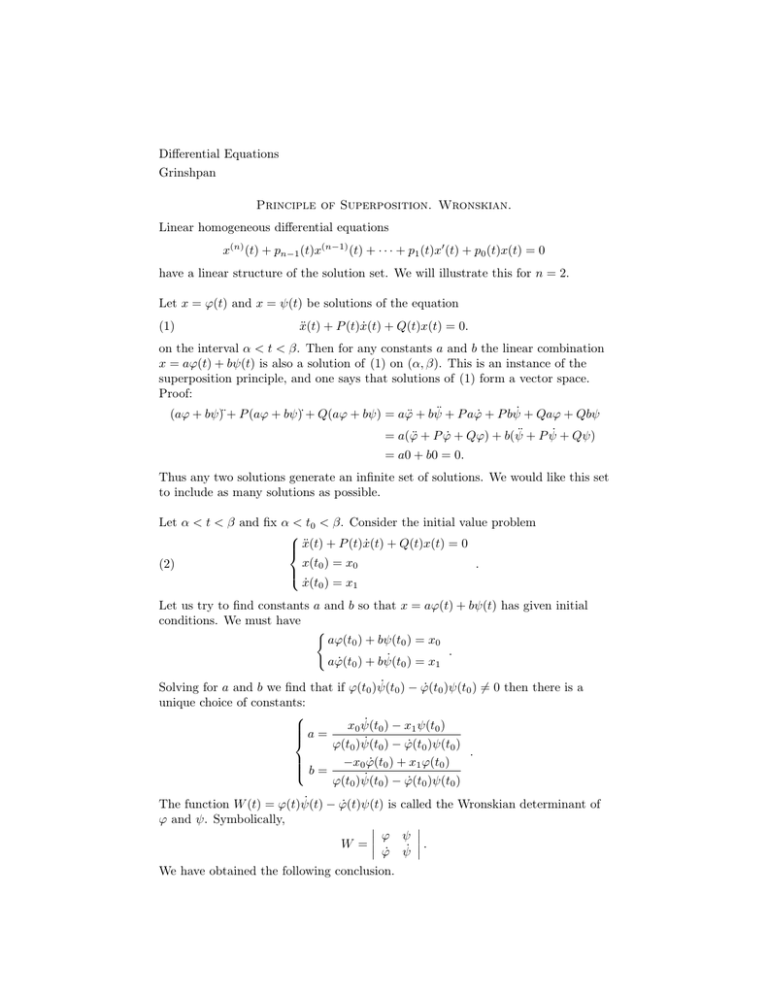
Differential Equations Grinshpan Principle of Superposition. Wronskian. Linear homogeneous differential equations x(n) (t) + pn−1 (t)x(n−1) (t) + · · · + p1 (t)x0 (t) + p0 (t)x(t) = 0 have a linear structure of the solution set. We will illustrate this for n = 2. Let x = ϕ(t) and x = ψ(t) be solutions of the equation (1) ẍ(t) + P (t)ẋ(t) + Q(t)x(t) = 0. on the interval α < t < β. Then for any constants a and b the linear combination x = aϕ(t) + bψ(t) is also a solution of (1) on (α, β). This is an instance of the superposition principle, and one says that solutions of (1) form a vector space. Proof: (aϕ + bψ)¨+ P (aϕ + bψ)˙+ Q(aϕ + bψ) = aϕ̈ + bψ̈ + P aϕ̇ + P bψ̇ + Qaϕ + Qbψ = a(ϕ̈ + P ϕ̇ + Qϕ) + b(ψ̈ + P ψ̇ + Qψ) = a0 + b0 = 0. Thus any two solutions generate an infinite set of solutions. We would like this set to include as many solutions as possible. Let α < t < β and fix α < t0 < β. Consider the initial value problem ẍ(t) + P (t)ẋ(t) + Q(t)x(t) = 0 x(t0 ) = x0 (2) . ẋ(t0 ) = x1 Let us try to find constants a and b so that x = aϕ(t) + bψ(t) has given initial conditions. We must have ( aϕ(t0 ) + bψ(t0 ) = x0 . aϕ̇(t0 ) + bψ̇(t0 ) = x1 Solving for a and b we find that if ϕ(t0 )ψ̇(t0 ) − ϕ̇(t0 )ψ(t0 ) 6= 0 then there is a unique choice of constants: x0 ψ̇(t0 ) − x1 ψ(t0 ) a = ϕ(t0 )ψ̇(t0 ) − ϕ̇(t0 )ψ(t0 ) . −x0 ϕ̇(t0 ) + x1 ϕ(t0 ) b= ϕ(t0 )ψ̇(t0 ) − ϕ̇(t0 )ψ(t0 ) The function W (t) = ϕ(t)ψ̇(t) − ϕ̇(t)ψ(t) is called the Wronskian determinant of ϕ and ψ. Symbolically, ϕ ψ . W = ϕ̇ ψ̇ We have obtained the following conclusion. 2 Conclusion. Let ϕ(t) and ψ(t) be solutions of (1) on (α, β). If W (t0 ) 6= 0 then every initial value problem (2) is solvable. In fact, (2) has a unique solution of the form aϕ(t) + bψ(t). Example. Let t > 0 and consider the initial value problem 2 ẍ(t) − 2/t x(t) = 0 x(1) = 0 . ẋ(1) = 2 By inspection we can check that ϕ(t) = t2 and ψ(t) = 1/t both satisfy ẍ(t) − t22 x(t) = 0. However neither function has the right initial conditions: ϕ(1) = 1, ϕ̇(1) = 2 and ψ(1) = 1, ψ̇(1) = −1. The Wronskian of ϕ and ψ at t = 1 is 1 1 W (1) = 2 −1 = −3 6= 0. Hence there are constants a, b such that x = at2 + b/t is a solution of our initial value problem. A short computation gives −2 2 2 1 2 x(t) = t + = (x2 − 1/t). −3 −3 t 3
